Indigenous Use and Commercialization of Urtica dioica l. from Local Communities of Kieni West Sub County, Nyeri County, Kenya
Article Information
Joseph Wairimu Kamicha*, Rebecca N. Karanja , and Grace W. Ngaruiya
1School of Pure and Applied Sciences, Department of Plant Sciences, Kenyatta University, P.O Box 43844-00100, Nairobi, Kenya.
*Corresponding Author: Joseph W Kamicha. School of Pure and Applied Sciences, Department of Plant Sciences, Kenyatta University, P.O Box 43844-00100, Nairobi, Kenya,
Received: 20 January 2023; Accepted: 27 January 2023; Published: xxxxx
Citation: Joseph Wairimu Kamicha, Rebecca N. Karanja, and Grace W. Ngaruiya. Indigenous Use and Commercialization of Urtica dioica l. from Local Communities of Kieni West Sub County, Nyeri County, Kenya Journal of Environmental Science and Public Health 7 (2023): 25-30.
View / Download Pdf Share at FacebookAbstract
Though the stinging nettle (Urtica dioica L.) is categorized globally as an invasive species and nuisance weed due to its stinging trichomes, the plant is a source of vital nutrition and an ingredient in many indigenous medicine practices. Urtica dioica has a dense rhizome that ensures its survival, enduring adverse climatic conditions throughout the year. Hence, this study sought to determine indigenous knowledge on the uses of U. dioica by the local communities in three parts of semi-arid Kieni Sub County namely Endarasha, Charity, and Watuka. Questionnaires were administered to 196 local informants on the diverse indigenous uses of U. dioica. Independent sample t-test showed no significant difference (P>0.05) in the use of U. dioica as a medicinal plant across gender. 100% of the respondents rated U. dioica as among the most consumed vegetable. Thirdly, the study established the use of U. dioica in the food, medicine, and veterinary sector. Lastly, despite prolonged adverse climatic conditions in the Kieni region, there has been a general increasing trend of U. dioica invasiveness over the last 10 years. Such consumption, coupled with the resistance of U. dioica to harsh climatic changes could indicate the future economic potential of the plant species in the local cottage industries to support the government's food production and manufacturing agenda. This study recommends increasing public awareness of the benefits of U. dioica to boost its consumption.
Keywords
Indigenous knowledge, abundance, primary health care, biodiversity, invasiveness, Urtica dioica.
Indigenous knowledge articles; abundance articles; primary health care articles; biodiversity articles; invasiveness articles; Urtica dioica articles.
Article Details
1. Introduction
Stinging nettle (Urtica dioica L.), an indigenous perennial species with European origins, is primarily found in moist, fertile, disturbed habitats [1]. This plant is well-known for its stinging hairs, and when touched, it releases toxins like histamine which cause irritational discomfort, therefore cattle will occasionally eat U. dioica as a result [2]. As a food item, U. dioica leaves possess vitamins, fat, protein, carbohydrates, and minerals, also, besides trace elements, and are therefore used as vegetables and tea in India [3]. Urtica dioica is reported to have been used by Europeans and Native Americans for making linens and sailcloth back in the 17th century [4].
In Kenya, U. dioica is popular among the Kikuyu and Meru communities, commonly known as “thabai/Hatha” or “thaa,” respectively, and is used as a traditional vegetable. Dried leaves are ground into a powder used to make porridge flour [5]. Sometimes it is added to mashed food to enrich it with nutrients [6]. As a way of enhancing food sufficiency, there is, therefore, a need to boost the widespread cultivation of organic U. dioica [7].
A study on the use of stinging nettle in Nyeri County by both urban and local communities found that 52.9% use the species to treat diabetes as an indigenous medicinal herb, with over 25% using the plant to treat high blood pressure, arthritis, rheumatism, and allergies. Such uses necessitate the need for research on the cultural knowledge guiding this valuable species' food and medical use in Kenya [8].
Globally, U. dioica has been categorized among the invasive species belonging to the family Urticaceae [9]. Though U.dioica cultivation has often been neglected due to its irritant stinging hairs and reduction of yield to other agriculturally vital food plants, it is a source of vital nutrition and an ingredient in many indigenous medicine practices [10]. With an urgent need to embrace drought-resistant food crops, U. dioica remains a vital herbaceous species, due to its dense rhizome that ensures its survival, enduring adverse climatic conditions throughout the year [11]. If the cultivation of U. dioica is well managed, its ability to persevere adverse climatic conditions can ensure sustainable food production, especially in semi-arid areas such as the Kieni sub-county in Kenya. Studies have also shown that the establishment of U. dioica along riverbanks, fence rows, and roadsides neighboring croplands, outcompetes cultivated crops and often becomes a problematic weed in residential areas [12]. Due to its stinging trichomes, the plant creates nuisance environments, especially in urban and residential areas. Such global studies reveal the need for indigenous knowledge on uses of U. dioica by local communities of Nyeri County and Central Kenya in general which can be applied in the exploitation of this species aimed at more consumption as a way of managing its invasiveness. The objective of this study was intended to produce data on the uses of U. dioica locally which could potentially shed light on commercial and value addition to the plant which can help in exploiting the plant hence reducing invasive impacts to biodiversity and problems associated with agriculture.
2. Methods
2.1 The Study Area
The study area was composed of three sub-locations namely; Endarasha, Charity, and Watuka from Kieni Sub-County in Nyeri County (Figure 1). Kieni Sub-County is located between latitude 360 47' 25.665" E and longitude 10 16' 46.111" N. (Figure 2.1). There are about 198,901 people living in the area which has an area of about 817.1 km2 [13]. The Kieni region is categorized as semi-arid since it receives only 500 mm of precipitation annually. The region also has a hot, dry climate with little, erratic rainfall that varies frequently across time and distance [14]. In the Kieni region, the seasons of brief rains (about October or November) and long rains (around March or April) are bimodal [15].
Kieni East and West together occupy 52 percent of Nyeri County's total land area. Agro-pastoralism, mixed farming, and formal and informal employment represent the majority of people's occupations (Figure 2) [16]. The rivers Mwiyogo and Ngaring'iro are among the principal waterways in this area. In Endarasha, where black cotton soils predominate, farmers mostly cultivate maize, Irish potatoes, and onions as a cash crop, while in Watuka and Charity, where red soils predominate, farmers primarily grow cabbage and carrots in addition to maize [17]. The Kieni sub county's soil pH ranges from slightly alkaline (8.1) to slightly acidic (5.2). [17].Because Endarasha experiences more rainfall than Watuka and Charity due to their proximity to the Aberdare hills, the latter was chosen to serve as a control [18].
2.2 Sampling method
The survey was conducted in the three sub-locations of the Kieni west sub-county, Endarasha, Charity, and Watuka, from April 2021 to December 2021 aimed at documenting local people’s indigenous knowledge of the uses of U. dioica.
Single-stage cluster sampling was used to identify households from villages in Watuka, Endarasha, and Charity for the study. This was guided by visual observation from a reconnaissance survey on villages that had encountered an invasion of U. dioica. The data on local people’s indigenous knowledge about U. dioica was obtained from household heads comprising 98 men and 98 women through questionnaires. Research assistants were used to interpret research questions for the respondents. Cluster sampling has high external validity since the sample selected reflects the characteristics of the entire population [19].
2.3 Data management and analysis
2.3.1 Indigenous knowledge on the uses of dioica in local communities.
Based on the age and gender of members of different households, local communities were surveyed using the questionnaire forms to obtain information on the uses of U. dioica as food, feed supplements, herbal medicine, abundance, rainfall requirements, and phenology. Based on the population of the study area (110,376), single-stage cluster sampling was used to identify households from villages in Watuka, Endarasha, and Charity for the study. The data on local people’s indigenous knowledge about U. dioica was obtained from household heads comprising 98 men and 98 women through questionnaires. During the sampling process, different age groups were included to accommodate the views of both youths and older members of the society since they may have different perceptions of the use of indigenous plants such as U. dioica. Where possible household heads were interviewed since they are known to make key decisions concerning the use of indigenous plants such as U. dioica for various purposes. Their presence in the study area based on their age makes their experience become acknowledged often by the other members.
The sample size was calculated using fisher's equation;
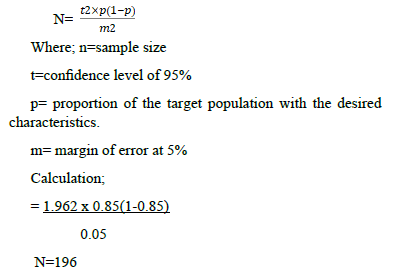
Qualitative data from indigenous knowledge on the uses of U. dioica in local communities were analyzed using International Business Machine Statistical Package for Social Sciences (IBMSPSS) version 20. The results were summarized using descriptive and inferential statistics.
3. Results
3.1 Indigenous knowledge of the uses of dioica in local communities.
3.1.1 Use of Urtica dioica for medicinal purposes
All the respondents (100%) reported having used U. dioica for medicinal purposes. It was noted that water from boiled leaves is locally used to manage arthritis and treat diabetes in human beings. Products obtained from leaves were found to be used locally as herbal tea. Water from boiled leaves and roots is given to a cow that has recently calved and lacks the strength to stand upright to act as an alternative source of minerals such as calcium. Likewise, dried leaves were noted to be given to laying chickens to induce the yellowing of egg yolk aimed at enhancing their marketability.
3.1.2 Preparation methods
All the respondents (100%) indicated that they used decoction and infusion as methods of locally extracting medicinal value from U. dioica roots, leaves, and stems.
3.1.3 Level of the usefulness of dioica
The figure below shows the uses of U. dioica and the level of importance attached by the respondents.
From the study, it was concluded that 50% of the respondents reported using U. dioica as human food mainly as vegetables and food additives, and 33% of the respondents noted that the use of U. dioica as medicine is very useful mainly in the management of diabetes, 14% of the respondents noted that dried leaves of U. dioica are useful when used as cattle feeds especially during droughts to substitute reduced animal fodder while only 3% of the respondents considered use of U. dioica as chicken feeds aimed at increasing nutritional quality of eggs to be very useful
3.1.4 General trend on the abundance of dioica over the past ten years
Within the study area
From the study, 67% of the respondents indicated that there has been an increasing trend in the level of invasiveness of U. dioica while only 33% reported a decreasing trend in the level of invasiveness of U. dioica in the study area (Figure 4). Resistance to weather changes and its invasive nature were noted as the reasons for its increasing trends while increased cultivation and construction due to increased settlement were cited as the reasons for the reduced abundance of U. dioica.
3.1.5 Consumption of dioica in comparison to other vegetables
The study found that 100% of the respondents rate U. dioica as among the most consumed vegetable in the study area because it is readily available in its natural habitats as an invasive species. Furthermore, it was noted that the plant products are readily available in the local markets.
3.1.6 Source of dioica by local communities
The results indicated that 61% of the respondents obtain U. dioica from the nearby Aberdare forest. While 39% had set aside an area within their farms for the growth of U. dioica.
3.1.7 Use of U. dioca as a medicinal plant for primary health care
Results analysis of the indigenous knowledge on the use of U. dioica as a medicinal plant across gender is presented in table 1. Independent sample t-test was performed to compare the use of U. dioica as a medicinal plant for primary health care across gender. There was no significant difference (P>0.05) in the use of U. dioica as a medicinal plant across gender. It was noted that the use of U. dioica as a medicinal plant increased with an increase in age. Individuals aged 60 years and above had a high preference for using medicinal plants (65%) for primary healthcare as compared to younger members of the community.
|
Use of U. dioca as a medicinal plant for primary health care across gender |
|
|
Pearson correlation |
0.8062 |
|
Sig. (two-tailed) |
0.076 |
|
N |
198 |
|
CI |
95% |
Table 1: Use of U. dioca as a medicinal plant for primary health care across gender
4. Discussion
4.1 Indigenous knowledge of the uses of dioica in local communities.
From the study, it was noted that significant consumption of U. dioica products ranges from food to medicine. One of the distinguishing reasons for the high consumption of U. dioica as food and herbal tea is it's widespread in many countries, especially in the Morocco, and its high digestibility together with the high mineral contents of U. dioca leaves [20].
The study also found that there has been a general increasing trend of U. dioica invasiveness over the last 10 years. This was attributed due to its resistance to weather changes, in addition to its good adaptation for dispersal. Urtica dioica dense rhizome has been noted to ensure its survival enduring adverse weather changes throughout the year [21].
All respondents in the study agreed to have used U. dioica as vegetables. It has also been noted that high consumption of U. dioica, is primarily in form of fresh vegetables whereby it is added to soups, cooked as a potherb, or used as a vegetable complement in dishes [22].The study found the invasive nature of U. dioica as the main reason for the failure of farmers to cultivate the plant on their farms. It was also noted that farmers who had attempted to cultivate the plant for commercial and domestic consumption later found it difficult to control it due to its fast growth rate and its ability to suppress other food crops. It has also been noted that, despite its promising potential as a food crop and its low input requirements, U. dioica has been underestimated and often considered a difficult weed to control in the agricultural sector due to its invasiveness [23].The majority of members of the community, therefore, are noted to rely on naturally growing U. dioica in the Aberdare forest and on their farms where it grows as a weed. This study was found to agree with the findings of Tarus et al. [8] that members of the Nyeri community extract stinging nettle for domestic and commercial purposes from the Aberdare forest. The study established that older members of the community above sixty years of age have a high preference for using U. dioica for medicinal purposes as compared to younger members. This was found to concur with the study conducted in Nigeria by Adebo et al. that older women had more experience in the use of herbal medicinal plants [24]. Roots, leaves, and stems were noted as the parts that have medicinal value in U. dioica. Locally water boiled from the leaves of U. dioica is used to treat arthritis and diabetes in human beings. Urtica dioica has been noted as an alternative drug by local communities for diabetes [25]. Decoctions from roots, leaves, and stems are used locally to boost blood levels in human beings. Through infusion, it was noted that U. dioica is used as an herbal tea by soaking leaves of U. dioica in boiled water and allowing it to cool. There has been high administration of nettle products such as nettle tea compared to nettle soup [26]. Locally water from boiled roots and leaves is given to cows that lack the strength to stand upright after calving to act as an alternative source of minerals such as calcium. Stinging nettle leaves have been reported to contain a wide range of nutritional values including the source of energy, protein, fiber, and minerals including iron, manganese, potassium, and calcium [27].
Conclusion
Poor methods of preparation and processing by local vendors consequently lower the quality of the U. dioica products. Locally, members from Endarasha, Charity, and Watuka suffering from arthritis, blood pressure, and diabetes self-medicate themselves using extracts from U. dioica. The study established that during drought, water from boiled leaves and roots is given to a cow that has recently calved and lacks the strength to stand upright to act as an alternative source of minerals such as calcium. Locally, laying chicken is fed with dried U. dioica powder to induce the yellowing of egg yolk aimed at enhancing their quality and marketability. Due to the invasive and stinging nature of U. dioica, it has not been fully cultivated. It is also evident that control of its spread by farmers through weeding and the use of herbicides in the agricultural sector has increased the cost of production. There is therefore a need to increase public awareness of the benefits of U. dioica to boost its consumption hence reducing its invasiveness.
Acknowledgments
The authors would like to extend their deepest gratitude to the input of the field research assistants, all correspondents from Kieni subcounty who provided much needed information about U. dioica and members of Kenyatta University Plant Sciences Department for their contribution during research work in Kenya.
Funding sources:
This study was conducted without funding from any organization
Conflict of interest:
No conflict of interest
List of Abbreviations and Acronyms
IBMSPSS International Business Machine Statistical Package for Social Sciences
KPHC Kenya Population and Housing Census
NAAIAP National Accelerated Agricultural Inputs Access Programme
References
- Swearingen J, B Slattery, K Reshetiloff, et al. Plant Invaders of Mid-Atlantic Natural Areas, 4th ed. National Park Service and U.S. Fish and Wildlife Service. Washington, DC 10 (2010): 43-44.
- Taylor K. Biological Flora of the British Isles: Urtica dioica Journal of Ecology 97(6) (2009): 1436-1458.
- Jan KN, zarafshan K, and Singh S. Stinging nettle (Urtica dioica): A reservoir of nutrition and bioactive components with great functional potential. Journal of Food Measurement and Characterization 11(2) (2017): 423–433.
- Srivastava N, & Rastogi D. Nettle fiber: Himalayan wonder with extraordinary textile properties. International Journal of Home Science 4(1) (2018): 281-285.
- Ndirangu M. Stinging plant can put a fortune in your pockets, Daily Nation 7 (2015).
- Murugu KD. Food Recipes, The Food and Agriculture Organization of the United Nations(F.A.O.) and The Ministry of Health, Republic of Kenya and Ministry of Agriculture and Irrigation 10 (2018): 229.
- Kregiel D, Pawlikowska E, and Antolak H. Urtica spp.: Ordinary Plants with Extraordinary Properties. Molecules?: A Journal of Synthetic Chemistry and Natural Product Chemistry 23(7) (2018).
- Tarus GK, & Mutiso FM. The Medicinal And Diet Base value of Stinging Nettle (Urtica massaica) To The Rural and Urban Livelihoods Within Aberdare and Mt. Kenya forest Landscapes 6(6) (2019): 12.
- Xu X, Guignard C, Renaut JF, et al. Insights into Lignan Composition and Biosynthesis in Stinging Nettle (Urtica dioica L.). Molecules 24(21) (2019): 3863.
- Shackleton RT, Richardson DM, Shackleton CM, et al. Explaining people's perceptions of invasive alien species: A conceptual framework. Journal of environmental management 229 (2019): 10-26.
- Arthur Lee. Wild Plants of Greater Seattle.4 (2001): 1-3.
- Schellman AE, A Shrestha, Parlier. Burning & Stinging nettles Integrated Pest Management for Home Gardeners and Landscape Professionals, Publication 74146 (2008): 1-3.
- Kenya Population and Housing Census: Nyeri County Statistical Abstract. 12 (2019): 1-16.
- Maina J, Wandiga S, Gyampoh B. Analysis of Average Annual Rainfall and Average Maximum Annual Temperature for 30 years to Establish Trends in Kieni, Central Kenya. Open Access 3(2) (2020): 4.
- Nderitu M, Oludhe C, Ali AA, et al. Analysis of rainfall and temperature variability in Kieni; Nyeri County. International Journal of Innovative Research and Development 5(2016).
- Mutunda D. A Joint Report by the Food security steering group (KFSSG), and Nyeri County Steering Group (C.S.G.) 5(2017): 1-3
- NAAIAP K. Soil suitability evaluation for maize production in Kenya. Nairobi, Kenya 10 (2014): 1378-1395
- Nyingi DW, Gichuki N, & Ogada MO. Freshwater ecology of Kenyan highlands and lowlands. In Developments in Earth Surface Processes 16 (2013): 199-218.
- Rapp T, Peters C, & Dachsbacher C. Void-and-cluster sampling of large scattered data and trajectories. IEEE transactions on visualization and computer graphics 26(1) (2019): 780-789.
- Said AAH, Otmani IS E, Derfoufi S, et al. Highlights on nutritional and therapeutic value of stinging nettle (Urtica dioica). International Journal of Pharmacy and Pharmaceutical Sciences 7(10) (2015): 8-14.
- Perry EJ. How to manage pests, pests in gardens and landscapes. The University of California, Davis, CA 6 (2010): 95616.
- Rutto LK, Xu Y, Ramirez E, et al. Mineral Properties and Dietary Value of Raw and Processed Stinging Nettle (Urtica dioica L.) International Journal of Food Science 2013(2013): 1-9.
- Di Virgilio N, Papazoglou EG, Jankauskiene Z, et al. The potential of stinging nettle (Urtica dioica L.) as a crop with multiple uses. Industrial Crops and Products 68(2015): 42-49.
- Adebo G, & Alfred S. The gender dimension of herbal medicine's knowledge and practice in Ekiti and Ondo States, Nigeria. Journal of Medicinal Plants Research 5(2011).
- Bisrat Hailemeskel Fullas F, & Unity Point Health-St. Luke’s. The Use of Urtica dioica (Stinging Nettle) as a Blood Sugar Lowering Herb: A Case Report and a Review of the Literature. Diabetes Research - Open Journal 1(5) (2016): 123–127.
- Kk MA, & Parsuraman S. Urtica dioica L. (Urticaceae): A stinging nettle. Systematic Reviews in Pharmacy 5(1) (2014): 6-8.
- Bauman H, & Perez J. Food as medicine: Stinging nettle (Urtica dioica, Urticaceae). HerbalEGram 15(7) (2018): 56.

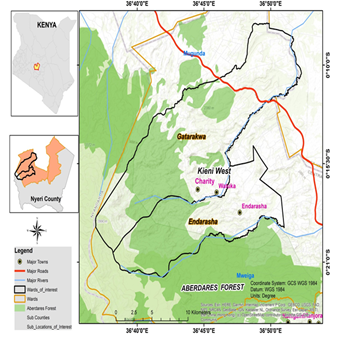
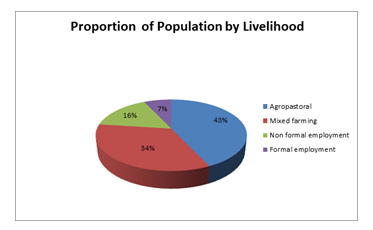
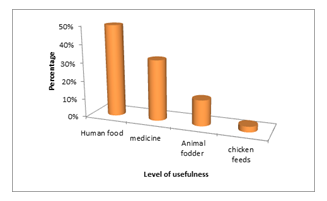
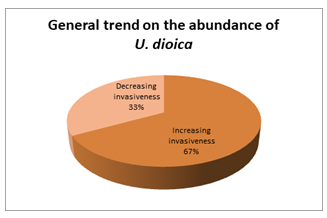

 Impact Factor: * 3.6
Impact Factor: * 3.6 CiteScore: 2.9
CiteScore: 2.9  Acceptance Rate: 11.01%
Acceptance Rate: 11.01%  Time to first decision: 10.4 days
Time to first decision: 10.4 days  Time from article received to acceptance: 2-3 weeks
Time from article received to acceptance: 2-3 weeks 